Every application in embedded vision is different. A ‘one size fits all’ approach doesn’t work when it comes to selecting a camera for your vision-guided system. One such unique requirement is NIR imaging or Near Infrared imaging.
NIR refers to the spectrum of light that lies in the wavelength range of 800 to 2500 nm. Depending on the end application requirements, the exact wavelength of the NIR light source might vary. At the same time, high-sensitivity NIR cameras are also capable of taking images without an external light source.
NIR cameras are used in vision systems that cannot capture the necessary image data under visible light. Applications such as surveillance systems that operate in scarce lighting environments are a great example of this. Examples of other devices powered by NIR cameras include traffic monitoring systems, agricultural drones, and access control systems (we will be covering the applications of NIR cameras in detail in an upcoming section).
How different are NIR cameras from ordinary camera modules? Why is NIR imaging required and how do they benefit modern-day camera applications? What are the vision systems that use NIR cameras? Let’s learn all these in this article.
What is an NIR Camera?
A NIR camera comes with the ability to take images in the NIR spectrum. NIR cameras include a high Quantum Efficiency (QE) value in the NIR spectrum. QE is a sensor parameter and is critical in maximizing the effectiveness of image capture.
Have a look at the graphs below and compare the difference in absolute QE values between the AR0521 and AR0522 sensors from onsemi:
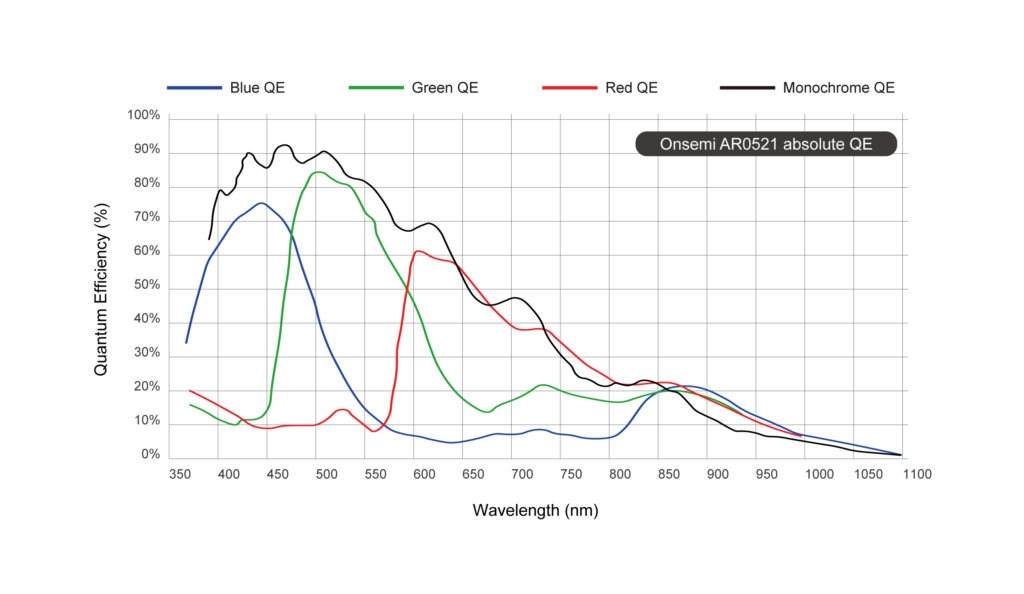
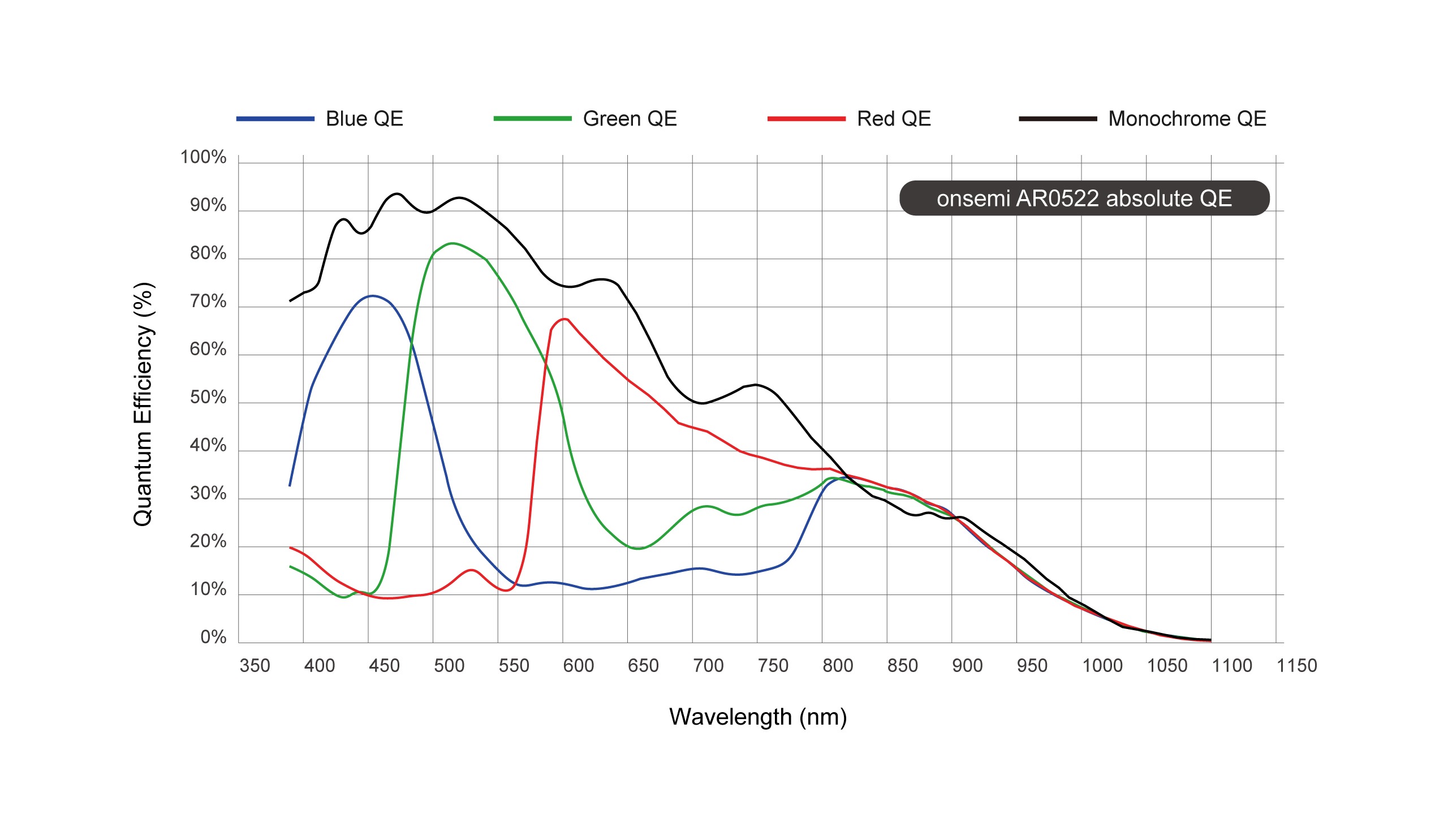
QE comparison of onsemi’s AR0521 and AR0522 sensors
AR0522 comes with the Near IR Enhancement functionality, which enhances its sensitivity within the near-infrared spectrum range (approximately 800 nm to 1000 nm), thus improving image quality and performance in low-light conditions. This is the main distinction between AR0522 and AR0521 when it comes to their abilities in the NIR spectrum.

Image quality comparison
TechNexion VCI-AR0522-CB is a camera solution that is optimized for NIR performance, particularly for outdoor applications. Our suite of products contains a wide variety of NIR cameras that can be further modified to fit the requirements of the end application.

USB3 Type-C Aluminium Enclosed Camera with onsemi AR0522 5MP Rolling Shutter with Onboard ISP + IR-Cut Filter + Incl. 1 Meter USB C Cable with C Mount Body
VCI-AR0522-CB
- onsemi AR0522 5MP Rolling Shutter Sensor
- Near Infra-Red Enhancement for Outdoor Applications
- Designed for Low Light Applications
- C-Mount for Interchangeable Lenses
- UVC USB Type-C 5 Gbps Connector
- Plug & Play with Windows & Linux OS
- VizionViewer™ configuration utility
- VizionSDK for custom development
| Sensor | onsemi AR0522 |
| Shutter | Rolling |
| Megapixels | 5MP |
| Chromaticity | Color, Monochrome |
| Interface | USB3 |

USB3 Type-C Aluminium Enclosed Camera with onsemi AR0522 5MP Rolling Shutter with Onboard ISP and S-mount lens + Incl. 1 Meter USB C Cable
VCI-AR0522-SL
- onsemi AR0522 5MP Rolling Shutter Sensor
- Near Infra-Red Enhancement for Outdoor Applications
- Designed for Low Light Applications
- S-Mount for Interchangeable Lenses
- UVC USB Type-C 5 Gbps Connector
- Plug & Play with Windows & Linux OS
- VizionViewer™ configuration utility
- VizionSDK for custom development
| Sensor | onsemi AR0522 |
| Shutter | Rolling |
| Megapixels | 5MP |
| Chromaticity | Color, Monochrome |
| Interface | USB3 |
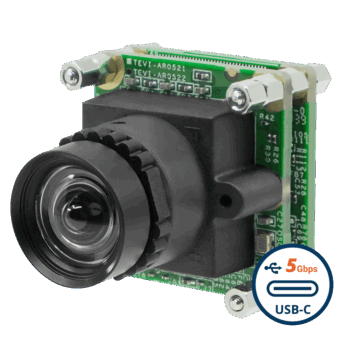
USB3 Type C PCB Board Level Camera with onsemi AR0522 5MP Rolling Shutter with Onboard ISP and S-mount Lens with IR-Cut Filter
UVCI-AR0522-SL
- onsemi AR0522 5MP Rolling Shutter Sensor
- Near Infra-Red Enhancement for Outdoor Applications
- Designed for Low Light Applications
- S-Mount for Interchangeable Lenses
- UVC USB Type-C 5 Gbps Connector
- Plug & Play with Windows & Linux OS
- VizionViewer™ configuration utility
- VizionSDK for custom development
| Sensor | onsemi AR0522 |
| Shutter | Rolling |
| Megapixels | 5MP |
| Chromaticity | Color, Monochrome |
| Interface | USB3 |
Why are NIR Cameras Required in Embedded Vision?
Near-infrared cameras are used in embedded vision primarily in two ways:
- To capture details (mostly textural) that cannot be done in the visible spectrum.
- To perform imaging in dim light conditions where the quality of visible light cameras does not meet the required standards.
In both cases, they enhance the ability of the vision system to deliver the necessary details which is otherwise not possible using the visible spectrum. This is a lifesaver in applications like iris recognition (commonly used in identity verification systems) where the system must capture unique patterns of the eye under an infrared light source.
In addition, NIR cameras come with the following advantages:
- They provide better visibility in adverse environmental conditions like darkness, smoke (fog or mist), etc.
- They offer better contrast in comparison with visible light cameras.
- A replacement for thermal cameras in certain cases, given that NIR cameras can read information just like an ordinary camera designed to function in the visible spectrum.
Earlier, NIR sensitivity was achieved using CCD sensors. However, with advancements in CMOS sensor technology, NIR cameras became more affordable while maintaining a smaller form factor.
Working Principle of NIR Cameras
NIR cameras house the same set of components as a visible light camera module. They come with a lens, a sensor array, a baseboard, and an interface to connect with the host system. The key difference lies in the ability of the sensor pixels to detect light in the NIR spectrum.
The comparison of cameras that work in the visible and NIR ranges is analogous to the difference between what humans and vampire bats can see with their eyes. While humans have sight only in the visible spectrum (which is where visible light gets its name from), bats and some species of snakes and beetles can sense IR light.
Now, if we are to compare the way NIR sensing works in CMOS and CCD sensors, there is a distinction between the two. CMOS sensors facilitate enhanced NIR imaging by increasing the thickness of the epitaxial layer. This means that the same camera system can be used for visible and NIR imaging, though there are a few limitations. However, in the case of CCD sensors, dedicated cameras must be used for RGB and IR/NIR imaging.
Applications of NIR Cameras
The applications of NIR cameras in embedded vision are very broad. The following lists applications across the agriculture, industrial, smart city, and medical industries where NIR cameras are used:
- Food and quality inspection
- Traffic monitoring
- Agriculture
- Iris recognition
- NIR fluorescence imaging
- Surveillance systems
Food and Quality Inspection

In general, near-infrared cameras are preferred over visible cameras for detecting damages and bruises – especially in fruits, vegetables, and food items. NIR images can surface issues that the naked human eye – or ordinary cameras – cannot detect. Because formations in produced goods that indicate damage are more absorptive of light in the NIR range, wrinkles, bruises, and other deformations are often better detected by NIR cameras.
These cameras are also used for checking surface irregularities, NDT (Non-Destructive Testing), and other industrial quality inspection processes to reduce wastage and improve output.
Traffic Monitoring
With the world becoming smarter, more countries around the world are building smart cities that automate different activities to improve public safety and convenience. Traffic monitoring is part of this smart city revolution where embedded vision systems are used for activities such as:
ALPR (Automatic License Plate Recognition)
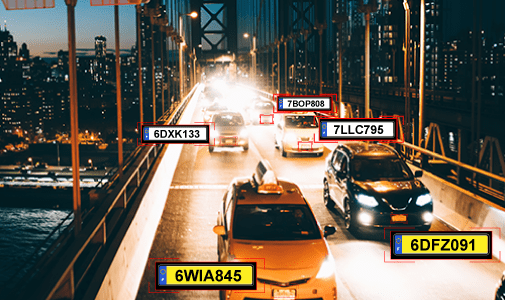
Vehicle and Pedestrian Counting

Speed Measurement

Detecting Traffic Violations
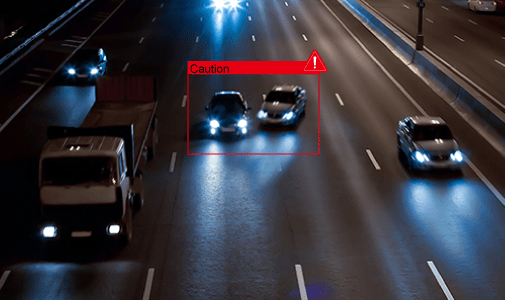
Not all traffic monitoring systems will need a NIR camera. If the device is installed in a location with adequate lighting (even during the night), a camera that operates in the visible spectrum alone will do the job. In the other case where lighting is limited, an NIR camera can offer better visibility and help capture license plates. A technique called OCR (Optical Character Recognition) is then applied to identify the vehicle by reading the characters on the plate.
Further, in some cases, additional lighting may not be desired since it is distracting or disruptive to human vision at night. Moreover, in speed-tracking applications, having an external light source would warn drivers to “slow down” before the speed camera does. As NIR light sources are not visible to the naked eye, it is ideal for use in these applications.
The same applies to the other functions of a traffic monitoring camera, where vehicle & pedestrian counting and violation detection can be better carried out with the help of NIR imaging if the lighting is not sufficient.
NIR Cameras for Agriculture
One of the most compelling applications of NIR cameras in agriculture is calculating NDVI (Normalized Difference Vegetation Index). NDVI is a metric that is used to determine the density and spread of green cover in agricultural land. This is calculated by taking the difference between visible and NIR reflectance of the vegetation cover. So, why are NIR cameras required for this?
Since calculating NDVI requires reflection data of both the visible and NIR bands, NIR cameras are a must-have. To measure NDVI across large areas, drones fitted with camera modules are used. These are high-resolution cameras that can capture images free of artifacts as the drones move. Depending on the complexity of the use case, a dedicated NIR camera sensitive only to near-infrared wavelength might be used while another camera captures image data in the visible spectrum. This image and video data are then fed into a software or algorithm that derives valuable insights about the health of the crops and the vegetation. Because this measurement is composed of comparing images of different spectra (NIR and visible wavelengths), this is a type of multispectral imaging.

NIR cameras for agriculture could also be used to analyze defects in food produced at the time of harvesting to sort them based on quality. In such a use case, cameras are embedded into what are called harvesting robots.
Iris Recognition

Just like fingerprints, the iris of every human is unique and remains unchanged throughout the individual’s life. Iris recognition is commonly used as a biometric identification tool in law enforcement, border control, and security systems.
Iris recognition involves capturing the images of the iris under visible light and infrared light. NIR cameras in iris scanners serve two purposes:
- They help to take certain unique features of the iris that cannot be clearly seen in the visible spectrum.
- They can perform imaging under low light conditions.
In both cases, NIR cameras complement visible cameras to ensure all the necessary details of the iris are captured.
NIR Fluorescence Imaging
Fluorescence imaging is a widely used technique in medical and life science applications. NIR fluorescence imaging is a subset of this technique that relies on the light in the NIR spectrum to capture reflections from the object.
One of the NIR fluorescence imaging techniques in medical diagnosis and treatment involves using a substance called ICG (Indocyanine Green). It can be used in processes like angiography, intraoperative assessment of vessel patency (the degree to which vessels are blocked or not blocked), tumor delineation, lymphatic architecture imaging, as well as other applications.

Surveillance Systems

The role of near-infrared cameras in surveillance systems is like that of traffic monitoring devices. Since many surveillance systems are deployed in areas with limited light supply such as indoor parking lots, warehouses, and mines, high-sensitivity NIR cameras are highly beneficial. Also, they have to do round-the-clock surveillance with the ability to capture theft and infiltrations during the night. Given these, NIR cameras can be a surveillance system’s best friend.
NIR Cameras in Indoor and Outdoor Environments
In outdoor conditions, the wavelength of the IR light under which you are capturing images also needs to be high. This is because the output might get tampered with due to interference from sunlight. For this reason, indoor NIR cameras mostly operate around a wavelength of 850nm while outdoor NIR cameras use 940nm (these are the two most used wavelengths in camera applications).
In the following articles, we will be sharing some great content on embedded vision and how modern cameras are changing the world for good. So, make sure you follow our content to get educated, entertained, and inspired.
Related Products
- What is an NIR Camera?
- Why are NIR Cameras Required in Embedded Vision?
- Working Principle of NIR Cameras
- Applications of NIR Cameras
- Food and Quality Inspection
- Traffic Monitoring
- NIR Cameras for Agriculture
- Iris Recognition
- NIR Fluorescence Imaging
- Surveillance Systems
- NIR Cameras in Indoor and Outdoor Environments
- Related Products
Get a Quote
Fill out the details below and one of our representatives will contact you shortly.



